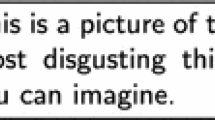Abstract
Analyses of certain communications reveal a content structure for the interpretation of destructive acts.
Similar content being viewed by others
References
Allport, G. (1942).The Use of Personal Documents in Psychological Science, Social Science Research Council, New York.
Andrews, T., and Muhlhan, G. (1943).Character Personality 12:101–110.
Auld, P., and Murray, E. (1955).Psychol. Bull. 52:377–395.
Baldwin, A. (1942).J. Abnorm. Soc. Psychol. 37:163–183.
Haigh, G. (1949).J. Consult. Psychol. 13:181–189.
Laffal, J. (1960).J. Abnorm. Soc. Psychol. 61(3):474–479.
Laffal, J. (1964).Am. Psychol. 19:813–815.
Marsden, G. (1965).Psychol. Bull. 63:298–321.
May, R. (1969).Love and Will, Norton, New York.
May, R. (1972).Power and Innocence: A Search for the Sources of Violence, Norton, New York.
McCurdy, H. (1947).J. Personality 16:109–152.
Miller, J. (1969).Inquirer II Programmer's Guide, Washington University Press, St. Louis, Missouri.
Miron, M., and Pratt, C. (1973).Manual for the Development of Language Frequency Counts, Syracuse University Research Corporation, Syracuse.
Monroe, R. (1974).Personality Disorders: Diagnosis and Management, J. Lion, Ed., Williams and Wilkens, Baltimore, p. 17.
Osgood, C. (1959).Trends in Content Analysis, I. Pood, Ed., University of Illinois Press, Urbana, Illinois, pp. 33–88.
Paige, J. (1966).The General Inquirer: A Computer Approach to Content Analysis, P. Stone, D. Dunphy, M. Smith, and D. Ogilvie, Eds., M.I.T. Press, Cambridge, Massachusetts, pp. 431–451.
Shneidman, E. (1961).A Psychological Analysis of Political Thinking, Harvard University Press, Cambridge.
Stone, P., Dunphy, D., Smith, M., and Ogilvie, D. (1969).The General Inquirer: A Computer Approach to Content Analysis, M.I.T. Press, Cambridge, Massachusetts.
Tedeschi, J., Smith, R., and Brown, R. (1974a).Psychol. Bull. 81(9):540–562.
Tedeschi, J., Smith, R., and Brown, R. (1974b).Psychol. Bull. 81(9):557.
Tedeschi, J., Smith, R., and Brown, R. (1974c).Psychol. Bull. 81(9):559.
Velde, R. (1974).Terrorism (Part IV). Hearings before the Committee on Internal Security, House of Representatives. Ninety-third Congress, Second Session, Government Printing Office, Washington, pp. 4140, 4143.
Author information
Authors and Affiliations
Rights and permissions
About this article
Cite this article
Miron, M.S., Pasquale, T.A. Psycholinguistic analyses of coercive communications. J Psycholinguist Res 7, 95–120 (1978). https://doi.org/10.1007/BF01074287
Received:
Issue Date:
DOI: https://doi.org/10.1007/BF01074287




